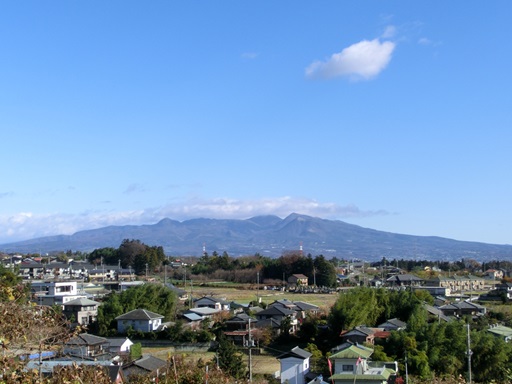|
Ruins of Minowa Castle

|
The ruins of Minowa Castle are located in the middle of Gunma Prefecture, where used to be Kozuke Province. Minowa Castle was built in 1512 by NAGANO Narimasa (1491 - 1561). NAGANO Clan was a powerful clan in this area and was a retainer of YAMANOUCHI-UESUGI Clan. YAMANOUCHI-UESUGI Clan was in the position of a "Kanto Kanrei", a shogunal deputy for the Kanto region in the Muromachi Age
(1336 - 1573)
.
TAKEDA Shingen (1521 - 1573) attacked Minowa Castle and captured the castle in 1566. TAKEDA Shingen
(1521 - 1573)
assigned his retainers as a keeper of Minowa Castle. After TAKEDA Clan was overthrown in 1582, Hojyo Caln governed Minowa Castle and this area.
In 1590, Hojyo Clan was also overthrown. TOKUGAWA Ieyasu
(1543 - 1616)
was transferred from Mikawa Province (present-day East part of Aichi Prefecture), Tootomi Province (present-day the west part of Shizuoka Prefecture) and Suruga Province (present-day the east part of Shizuoka Prefecture) to the Kanto Area. His retainer, II Naomasa (1561 - 1602) became a castle lord of Minowa Castle.
At the south of Minowa Castle, Minowa village is located. It would be a castle town in the Muromachi Age. There are a couple of old houses in the village.
If you walk to the north from Minowa Village, you will see Houbouji Temple.
Houbouji Temple was founded in the Heian Age
(794 - 1185)
.
Houbouji Temple is located in the site of Minowa Castle. When Minowa Castle was built, Houbouji Temple move to another place and after Minowa Castle was abandoned, the temple moved back to the original location.
The area between Minowa Village and Houbouji Temple was a wetland in the Heian Age. It is said that it was difficult for the enemies to attack Minowa Castle through the wetlands.
Behind Houbouji Temple, there is an entrance to the main castle area of Minowa Castle. A small trail leads to Kimata Bailey.
|
|
To the north of Kimata Bailey, a huge dry moat is located. The dry moat has ten meters in width and approximately three meters in depth. It is uncommon that a medieval castle has such a huge dry moat.
I walked through the huge dry moat, which is located between "Kimata" Bailey and "Kuruwa-Umadashi" Bailey. "Kuruwa-Umadashi" bailey was the small bailey, which protrudes from the second bailey to keep castle soldiers before castle soldiers make sortie.
|
|
The dry moat is very huge in width and depth.
If you walk to the east, you will arrive at the east end of Minowa Castle.
The ruins of Minowa Castle are located on a hilly area.
The view to the east opens up.
You will see Mt. Akagi from Minowa Castle.
At the east side of Minowa Castle, the site of "Karamete" Gate, the back gate, is located. The war flag shows the name of the castle, "Minowa Castle", and it celebrates Minowa Castle was nominated as one of the hundred most famous castles in Japan.
The hilly area behind the flower garden is the site of Minowa Castle.
I was back to "Kimata" Bailey and walked to the north through "Kuruwa-Umadashi" Bailey.
You will see an earth-paved bridge, connects between "Kuruwa-Umadashi" Bailey and the second bailey.
You will see other huge dry moats located on the both sides of the earth-paved bridge. These dry moats are covered by weeds.
|
|
The below picture shows the view of "Kuruwa-Umadashi" Bailey and the earth-paved bridge from the second bailey.
The enemies of "Minowa" Castle would approach the second and the main bailey through the earth-paved bridge. The earth-paved bridge is narrow, in order for the enemies would not be able to easily access to the second and the main baileys.
You will enter the second bailey through the earth-paved bridge. The second bailey has approximately 100m square area.
From the second bailey, castle soldiers made sortie at the battles.
To the west of the second bailey, the third bailey is located across the dry moat.
Each bailey in Minowa Castle is surrounded by dry moats.
|
|
To the south of the third bailey, "O-Horikiri" dry moat, the Huge-Dry Moat is located. "O-Horikiri" dry moat is almost completely covered by weeds. So that, it could not be seen.
Along the "O-Horikiri" dry moat, a castle trail runs from east to west.
You will see stone walls from the trail. In the west part of Japan, major castles built after 1580s had stone walls.
But, it is uncommon that castles in east Japan had stone walls.
|
|
The trail along the "O-Horikiri" dry moat will lead you to the "Koto" Gate at the west end of Minowa Castle.
The site of the "Koto" Gate was large.
When II Naomasa was the castle lord of Minowa Castle, the west was the front side of Minowa Castle.
The main gate was located three hundred meters to the south of the "Koto" Gate.
After coming back to the second bailey from "Koto" Gate, I walked to the north to the main bailey. You will see another huge dry moat between the second and the main baileys. The dry moat was well maintained and all weeds were removed. You will see how the dry moat is huge.
Beyond the huge dry moat, finally you will enter the main bailey. The main bailey has the area with a hundred meters north to south by seventy meters east to west.
|
|
The main bailey was surrounded by huge dry moats. At the north side of the main wall, another huge dry moat was located.
The below picture shows the bottom of the dry moat at the north of the main bailey.
You are able to walk to the dry moat, located at the west side of the main bailey from the north.
|
|
These huge dry moats defended Minowa Castle strongly. I was very impressed with these huge dry moats.
Further north of the main bailey, you will visit the New Bailey, where was the northernmost bailey of "Minowa" Castle.
You will see Mt. Haruna from the New bailey.
In 1598, II Naomasa moved to Takasaki in present-day Gumma Prefecture and Minowa Castle was abandoned.
Miniwa Castle was a large scale of the middle age castle. The dry-moats in Minowa castle are very impressive.
|
|
|
How to get there
From Tokyo, take a Jyoetsu or Hokuriku Shinkansen to Takasaki. From Takasaki, take a bus bound for Ikaho-Onsen. Take off a bus at "Shogakkou-Mae" or #Shiroyama-Iriguchgi" Bus Stop. The site of Minowa Castle is walking distance.
Other Historical Sites near by:
Ruins of Numata Castle
Mt. Haruna
Haruna Shrine
Tomioka Silk Mill
Ruins of Takasaki Castle
|
|

 Home Page in Japanese: "Shane's HomePage"
Home Page in Japanese: "Shane's HomePage"

 Home Page in Japanese: "Shane's HomePage"
Home Page in Japanese: "Shane's HomePage"